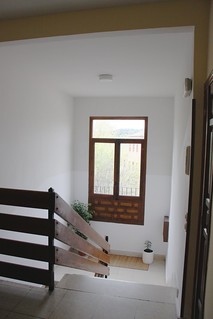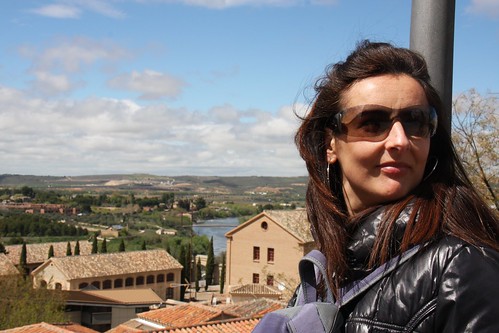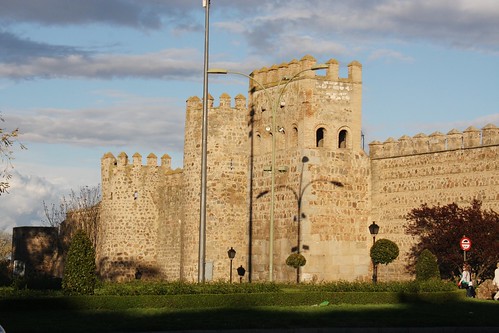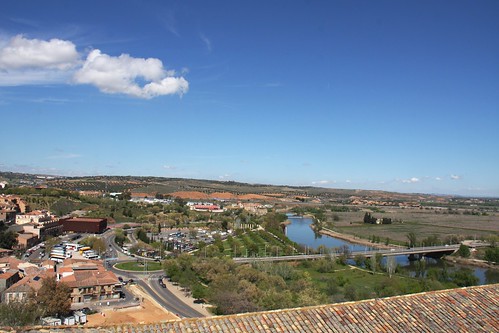Visiting El Greco - Toledo 2014

For many years now, my wife has expressed interest in visiting the Spanish city of Toledo. Although she's not much of an art aficionado, if you ever ask her who her favorite painter is, she'll reliably respond "El Greco". So when we saw on the news that there was a big exhibition to celebrate the quadricentenary of El Greco's death in 1614 (yesterday, April 7, was the actual date), in which his greatest works would be shipped from museums around the world to Toledo, it was not a matter of if, but when we would go. When we got an opportunity to leave the kids with my in-laws, we took it!

We set out on Friday afternoon – I picked Marga up directly at work – and we drove the five hours and twenty minutes down just south of Madrid to Toledo. This was our first usage of the internet lodging service, Airbnb, which I've been curious about and wanting to use for some time. Marga had come to me to tell me that all the hotels she could find were pretty expensive, so I went directly to airbnb.com and typed in Toledo, and the very first listing was a fellow named José who had a room to rent for 31€/night, for any number of people, right smack dab in the center of the old town.
Upon arrival, we would learn that the building used to be a university dormitory, and it feels very "institutional" – creepily so, even – with wider stairways and halls than a house or hotel would have. The first night we had the whole third floor to ourselves, staying in one of four or five rooms. Nothing about it was luxurious, but it was clean and warm and just what we needed. As I stated in my review on Airbnb, I would definitely stay there again, and recommend it to others. Having your lodging in the very center of town is very useful, and several times we chose to buy something and take it up to the room between tourist activities.

This was the view from our room on the third floor. View large.
Probably the most uncomfortable thing about Toledo is also a big source of its charm. All the parking is outside the city walls, and then you've got a pretty steep climb to get up into the well fortified city. We parked at the bus station and carried all our stuff up a solid fifteen minute walk that was steeply uphill the entire way. But, once you're inside the city, the lack of traffic really adds to the impression that you've traveled back in time.
What Toledo is known for
If you like swords, you've got to go to Toledo.
Toledo is probably most famous for it's period of La Convivencia, in which Christians, Muslims and Jews all occupied the city (and a good part of Spain) in relative peace. There was a very prominent Jewish Quarter, which made up a good part of the central city. As with most of Spain, the dominance of The Catholic Church was very omnipresent. When we asked our tour guide why there wasn't a Muslim Quarter, she gave the excuse that, really, if you look at the architecture, the whole city is very moorish. I agree, but there was much more emphasis on the history of the Jewish and Christian presence. We did enjoy the mosque that we visited, however.

Industrially, Toledo is famous for its metallurgy, specifically with steel swords. If you like swords, you've got to go to Toledo; every other shop is a swordmonger. I found it humorous that the sword industry has found it lucrative to follow Hollywood. There are many, many replicas of swords from The Lord of the Rings, and with more emphasis now, The Hobbit. Pretty much anything that is popular on the screen that involves blades was represented. Game of Thrones had a good representation. When I returned home, the first thing someone who knew where I'd gone asked me was, "Did you buy a sword?"
My wife and I don't care much for weapons, but we do love history and the romance of walking in really old places, which is what really made us fall in love with Toledo. If you love walking down old cobblestone streets that are several (perhaps a dozen) centuries old, then Toledo will charm your socks off. The street structure is very much like labyrinth, organically grown without any imposed organization. Some of them are so narrow that I joked that some Americans might not be able to fit down them, and everywhere you look, there's a dark nook or alley to investigate. It was enchanting!

A lovely little corner, just meters from the cathedral where we had breakfast on Saturday.

There were maps of the city embedded in the ground in various places. You can see how none of the streets are even remotely parallel.

The Synagogue of Santa María la Blanca. It's pretty representative of the history of Toledo: a Jewish synagogue, built with Muslim architecture, named after the Virgin Mary.

Our weather on Saturday was gorgeous!

At the El Greco Museum, a place built to represent, as best as historians can with partial information, the residence of Doménikos "El Greco" Theotokópoulos. This was not where the exhibition was.
All the tickets to the Museo Santa Cruz, where the El Greco 2014 exhibition was, were booked for the Saturday, so we had to go at 2pm on Sunday, which was later than we wanted, but we had to accept it. What was available on Saturday, however, was entrance into the Church of Santo Tomé, where one of El Greco's most famous works lives permanently: The Burial of the Conde Orgaz. My wife was eagerly anticipating seeing this painting, but, I think that even if no one had primed me to be amazed, it still would've floored me.
Rather than take a photo of the painting, like everyone around me, I realized that it's probably already been documented in hi-def on Wikipedia, so I was free to get lost in its detail. We spent about fifteen minutes just looking it over, and we could've spent much longer (as apparently Picasso and Dalí did). The detail and the paintings within the paintings were stunning. It was particularly creepy how El Greco painted himself into the painting; he's the only one looking "into the camera", so to speak. Many of the faces and objects looked positively photographic in quality. We were blown away.

On Saturday evening we took some of our purchases down to the car, so we found ourselves outside the city walls.

The sunset was lovely.

On Sunday morning we went to see this mosque, the Mezquita de Cristo de la Luz. Again, notice the renaming of another religion's building to something Christ-related. It was pretty tiny, but interesting, especially the grounds around it.

A fog rolled in briefly on Sunday morning.
The only other thing on our list before the El Greco exhibition was to see the Alcázar, an old Roman fortress that has served several military purposes over the years. Carlos I received Cortes there in 1521 after Cortes returned from beating down the Aztecs. We were a little dubious because the ALcázar has been turned into a Spanish Military Museum, which didn't interest us much, but once we got inside, we managed to find our way to the Patio de Armas, the parade ground, which was gorgeous.

And from above.

Cool.
They also had some old ornamental swords – this is Toledo, after all – which were pretty awesome.



That's some amazing metalworking talent!
Finally we went to the Museo Santa Cruz, which used to be an old hospital, to see the El Greco exhibition we'd come to Toledo principally to see. It was very, very cool. There was an awful lot of more boring commission work he'd done to pay the bills, but some of the works were quite stunning. I can't say that any of them had as big an impression on me as The Disrobing of Christ, which we saw at the cathedral (that's another blog post), or The Burial of Conde Orgaz, but they were very, very good. The most famous of which was the View of Toledo.
You can barely tell in the image here, but down on the river bank there are tiny little scratchings that let you make out humans bathing on the river bank. That's what most impressed me about El Greco's work: the tiniest little details that were perfectly sized and shaped to represent reality.

Just before we left, we stumbled upon The Original American Supermarket, which had me exclaiming "Jiffy Corn Muffin Mix!" "Fruit Loops!" and the names of several other American products that are impossible to get in Spain. Expats are easily excitable...

One last look down from the city walls towards the bus station where our car was parked. We got in the car and made it home in just over five hours in time to see our two lovely children to bed on Sunday night.
I leave you with my favorite of El Greco's masterpieces: The Gentleman with His Hand at His Breast.


